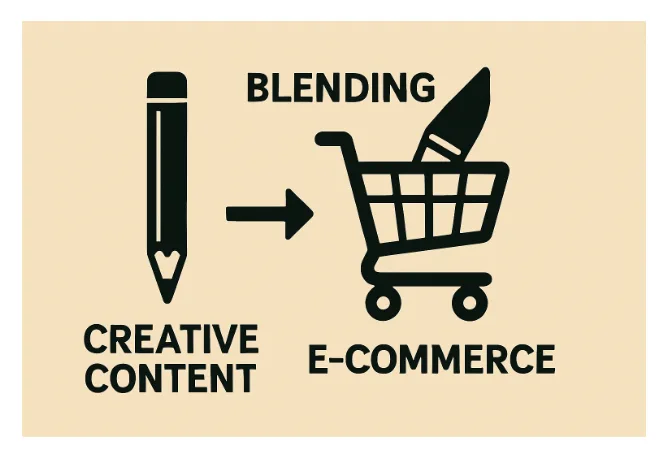The Benefits of Integrating Creative Content with Commerce Operations
The convergence of creative content and commerce operations has become essential for thriving in today’s digital economy. Brands now recognize that the ability to connect storytelling and product offerings leads to richer, more immersive customer experiences. By combining compelling digital narratives with practical commerce solutions, businesses are discovering new ways to engage their audiences and drive growth. Experts at Front Row emphasize that this merging of content-driven engagement and e-commerce infrastructure drives both loyalty and revenue.
As content and commerce merge, customers want more than transactions—they seek inspiration, education, and authenticity. Social media, websites, and campaigns evolve to offer value at every touchpoint. Creative integration makes customer journeys more engaging, fostering stronger relationships and boosting sales.
Interactive demos, influencer campaigns, and user content influence buying decisions, guiding customers from discovery to purchase. Companies that adapt to this shift will succeed. Leading brands create shoppable videos, immersive lookbooks, and real-time commerce to enhance the shopping experience, increase conversions, and understand consumer preferences.
Incorporating creative content elevates storytelling and authenticity, transforming visitors into engaged participants. Interactive features like quizzes and influencer partnerships deepen emotional bonds, with brands seeing up to 2.6 times higher purchase values. AI-driven personalized recommendations ensure product relevance, meeting informed consumers’ expectations for tailored experiences.
Key Takeaways
- Combining creative content with commerce operations increases customer engagement and conversion rates.
- Technological innovations, such as AI and automation, foster more seamless integration of content and commerce.
- Analyzing customer interactions across integrated platforms provides valuable data for business growth.
Streamlining the Path to Purchase
Frictionless journeys from discovery to transaction are vital to reducing cart abandonment and increasing purchase frequency. Direct checkout options embedded in content (such as “buy now” buttons within videos or social posts) remove obstacles and empower instant shopping decisions. Social commerce epitomizes this shift, where platforms like Instagram and Pinterest bridge the gap between inspiration and purchase, transforming the way people shop online.
As highlighted by The New York Times, integrating commerce into creative environments reduces the number of steps required for a buyer, leading to higher conversion rates and a streamlined checkout process. This approach not only shortens sales funnels but also meets the expectations of today’s convenience-driven consumer.
Leveraging Technological Advancements
Technology is at the heart of integrating content and commerce. Artificial intelligence, machine learning, and automation tools enable personalized product recommendations, dynamic pricing, and targeted content delivery. For example, brands utilize AI-powered copywriting to connect with customers on a personal level, resulting in significantly increased click-through and conversion rates.
Automation tools streamline content creation, distribution, and testing. They make it easier to scale campaigns, continuously optimize outcomes, and respond to customer feedback. Furthermore, augmented reality try-ons and virtual shopping experiences create hands-on, memorable ways for consumers to interact with products, bridging the gap between digital content and real-world buying decisions.
Gaining Valuable Customer Insights
The integration of content and commerce also serves as a powerful data source. By tracking how users interact with content and commerce features, brands receive actionable insights into preferences, pain points, and emerging trends. Access to rich customer data enables businesses to develop more informed audience segments, refine their messaging, and tailor products or services accordingly.
Employing advanced analytics tools further enhances the ability to capture and interpret data. This enables iterative improvements to marketing campaigns, ensures better content alignment with customer aspirations, and supports long-term growth strategies based on evidence, not guesswork.
Implementing Creative Commerce Strategies
1. Develop Engaging Content
Brands must routinely produce high-quality, relevant, and creative content that resonates with their target audience. Content should inspire, educate, or entertain, creating moments that customers want to share with others.
2. Incorporate Interactive Elements
Utilize shoppable videos, live streaming events, AR try-ons, and personalized shopping guides to foster engagement. Experimenting with new storytelling methods and technology ensures brands differentiate themselves in crowded digital spaces.
3. Utilize Data Analytics
Continually monitor and analyze customer interactions. Use the insights to optimize content, refine audience segments, and adjust messaging for maximum impact.
4. Leverage Technology
AI and automation platforms can streamline content creation, predict sales trends, and deliver personalized marketing campaigns at scale.
Conclusion
Blending creative content with commerce operations yields significant advantages, from fostering deeper customer engagement to driving sales growth. By investing in technology, leveraging strong analytics, and curating compelling brand stories, organizations stay ahead in an ever-evolving digital landscape. Adopting creative commerce strategies isn’t just a competitive advantage—it’s fast becoming an imperative for brands with aspirations for growth, loyalty, and marketplace relevance.






